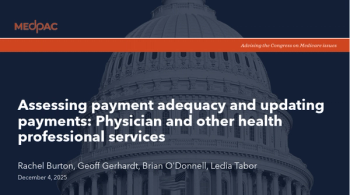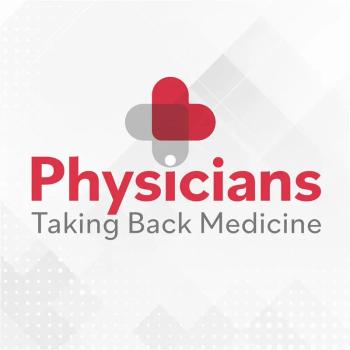
Arming doctors with evidence to achieve clinical and financial goals
By empowering physicians with evidence-based guidelines, they are better-equipped to make clinical decisions that are cost-effective and drive high-quality outcomes.
Editor's Note: Welcome to Medical Economics' blog section which features contributions from members of the medical community. These blogs are an opportunity for bloggers to engage with readers about a topic that is top of mind, whether it is practice management, experiences with patients, the industry, medicine in general, or healthcare reform. The opinions expressed here are that of the authors and not UBM / Medical Economics.
Physicians have never had a greater need for evidence-based information to evaluate the effectiveness and risks of alternative therapies and treatments. New reimbursement models include financial rewards for the delivery of quality, cost-effective care, which means doctors require tools that explicitly identify the value and risks of particular interventions, based on scientific research and evidence.
With ready access to current information, physicians can maximize their earning potential and diminish the risk of financial penalties, while simultaneously advancing the Triple Aim of improved population health, lower health costs, and a better patient experience.
If you are a physician, you’re aware of how challenging it can be to achieve Triple Aim goals and value-based care objectives. You often must a navigate a mix of old and new payment models; you must choose between the latest clinical protocols and possibly unaligned historical “best” practices; and, you must interpret population-level care guidelines and evaluate their applicability to an individual patient’s values and preferences.
Fortunately, thanks to a mix of new policies and regulations and advanced technologies that make evidence-based content more readily available, physicians are increasingly better-armed to achieve their care and quality goals.
Aligning evidence-based medicine and financial incentives
Most physicians still rely of traditional fee-for-service models for the bulk of their compensation. Newer fee-for-service plans, however, often include quality components that incent clinicians to follow evidence-based guidelines.
For example, established care guidelines recommend that patients with diabetes, hypertension and other chronic diseases regularly visit their doctor for preventative care and ongoing treatment. Often these guidelines align with physicians’ financial incentives so that clinicians encourage regular follow-up care to drive better outcomes.
Physicians that are subject to Medicare’s Merit-Based Incentive Payment System (MIPS) are also motivated to adhere to evidence-based medicine standards. Reimbursements and penalties under MIPS are tied to quality performance, so providers are driven to deliver optimal outcomes and cost-effective treatment.
Accountable care organizations (ACOs) also tie reimbursement to quality activities. Physicians have the potential to raise their quality scores and qualify for bonuses by adhering to evidence-based medicine protocols, especially under track 1 of the Medicare Shared Savings Program (MSSP). Physicians also have the potential to earn shared savings if the ACO reduces Medicare costs by more than a minimum amount-yet another reason for clinicians to seek evidence-based, cost-effective interventions.
By adhering to evidence-based medicine guidelines, physicians can earn higher rewards while participating in risk-based payment models, such as an ACO enrolled in track 2 or track 3 of the MSSP, or a Medicare Advantage plan administered by a private insurer. As reimbursement models continue to add value-based metrics, physicians will demand ready access to evidence-based protocols to guide preventive care efforts, better manage patients with chronic conditions, and minimizing unnecessary interventions.
Challenges to adopting evidence-based medicine
Despite aligned financial incentives and well-intentioned clinical practice guidelines, physicians are sometimes slow to utilize evidence-based medicine in clinical practice. This is especially true when new evidence challenges conventional wisdom.
Consider, for example, a well-publicized study that examined invasive therapy for stable coronary artery disease. In 2007,
Despite strong evidence, physicians often
Leveraging curated evidence to achieve clinical and financial goals
The incorporation of evidence-based medicine into everyday practice remains a challenge, but physicians now have increased access to more tools to help them evaluate the relative value of different interventions.
Consider the Choosing Wisely campaign, which the American Board of Internal Medicine launched in 2012. ABIM publishes
Other sources of evidence-based guidelines include the Cochrane Collaboration, specialty society “journal clubs,” and commercial providers of order sets and care plans. Such organizations perform systematic evaluations of new studies to assess their importance for patient outcomes. In addition,
By arming physicians with evidence-based guidelines, they are better-equipped to make clinical decisions that are cost-effective and drive high-quality outcomes. In order to achieve Triple Aim goals and value-based care objectives, healthcare organizations must leverage available technologies and resources and give their physicians ready-access to the most current evidence-based data.
Ross Ellis, MD is an ABIM-board certified internist and medical director at
Newsletter
Stay informed and empowered with Medical Economics enewsletter, delivering expert insights, financial strategies, practice management tips and technology trends — tailored for today’s physicians.
















